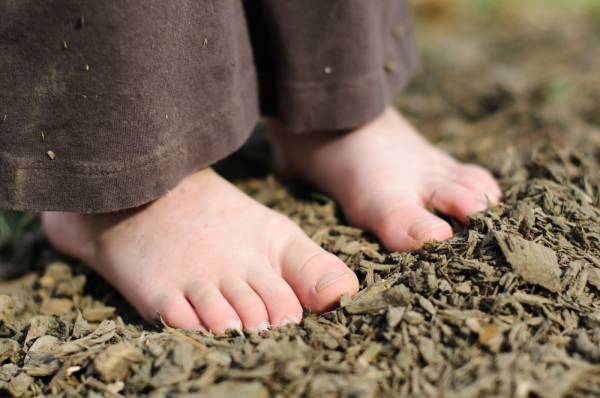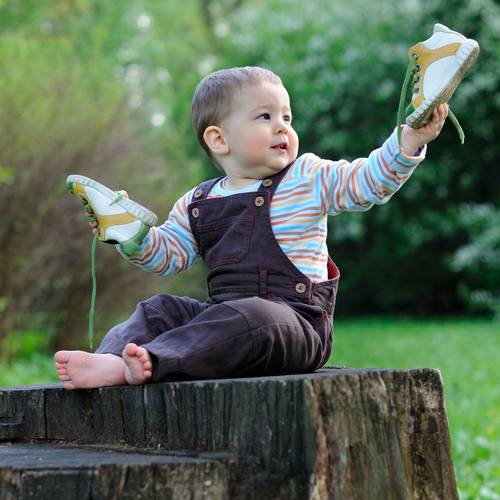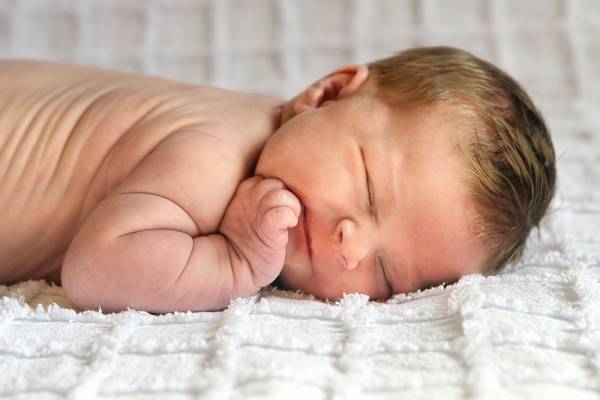“Put your shoes on!” “Don’t hang on the railing!” “Stay in your crib!” If you’ve spent a good amount of time with kids you’ve probably said at least one of these three things at some point. After all, kids need to wear shoes to protect their feet and help them develop. They shouldn’t hang from stuff because their arm might pop out of its socket (and they might break the railing). And using baby devices like cribs and playpens keeps them safe and out of trouble. To top it all off, all these things also make our lives a lot easier. Right?
One of my favorite people in the health and fitness blogosphere is Katy Bowman, expert in biomechanics and founder of the Restorative Exercise Institute. She has a lot of wonderful unconventional things to say about how to raise healthy children. Over the next weeks, I am happy to feature her biomechanical perspective on three topics that are more important during early childhood than many adults may realize: putting babies in shoes, letting them hang from stuff, and keeping them in cribs, carseats, swings, and other restraining devices.
Of course, these are very small pieces of the bigger picture that is early childhood development. But sometimes it helps to start with the little details when you want to affect the big picture. Bowman focuses on the biomechanics of human growth and development, which plays a critical factor in future health and wellness as well. You might wonder what biomechanics has to do with raising kids. Isn’t biomechanical science a holy grail of wisdom reserved for elite athletes and physical therapists? Why would a parent need to be thinking about this stuff? Here’s what Katy had to say:
Physical human development is phenomenal stuff. A baby comes out really soft. And I just don’t mean their skin! Their ‘bones’ aren’t really bones yet and how they move – specifically the initial loads placed on their body – can determine qualities like bone shape. When it comes to babies, most people are familiar with the “flat head” effect as a result of too much on-their-back time. But this bony adaptation to the environment happens all over the body, not just to the skull.
What we do as parents plays a crucial role in how these loads alter tissues. Many of the devices that we parents use regularly to make things more convenient play a role in this alteration. Some babies and toddlers spend just as much time in cribs, playpens, car seats, strollers, and high chairs as they do crawling around and getting into trouble. This certainly makes life easier for the caregivers, but does it have any effect on development? Katy noted the relation between these devices and more permanent biomechanical issues:
Over the decades, there has been a myriad of baby-devices created; things that make dealing with a baby more convenient. But a lot of these items affect human development in different ways, by altering the load types or load frequencies to the baby’s tissues. The results range from delayed milestones, which aren’t necessarily a huge deal, to more permanent changes to hip sockets and gait patterns.
So what’s an Information Age parent to do? After all, if What to Expect says it’s okay, you’re probably safe, right? Katy suggests we look to a different paradigm: the Hunter-Gathering (H-G) populations of ages past, and those that still occupy our planet. What new approach could these populations have to offer the Industrialized world, and what role does biomechanics play in that perspective?
When you compare load types and frequencies placed on early infants (what I call “baby biomechanics”) in Industrialized nations to those in Modern H-G populations, you can see how the latter maximizes the early strength-to-weight ratio. Hunter-Gatherer children are extremely capable, for lack of a better word. Their physical prowess and ability to negotiate their space is much closer to an adult, comparatively speaking. As our kids continue to decrease in health, taking a look at a more natural approach to movement can offer a different perspective.
When we consider many of the modern health crises in childhood – obesity and childhood diabetes, to name a few – it seems that perhaps we can learn a thing or two from this new perspective. One of the most obvious and striking differences between the two is the amount and type of movement that takes place during early childhood. These loading patterns during infancy and toddlerhood can create a domino effect that affects mobility, muscle development, and stability well into adulthood. In particular, as Katy noted, daily habitual practices can alter body position, load time, and bodily shape:
The shape their bones take as they firm up is a result of the loads and geometry of their body while they are loaded. Which means the positions they cycle through daily, the position of their body relative to the gravitational force, and the quantity of load-time will set the shape of their pelvis, the quality of their hip mobility, the muscle development in their feet, legs and core – which all affect their lung inflation. The stability of their knees. I could go on and on. And about this, I usually do. So much of what people battle against in their adult body stems from the strength profiles and movement patterns they developed in the first few years.

This all sounds great in theory, but where do we start as parents, caregivers, and coaches? Today we’ll address one issue that has a tremendous impact on baby biomechanics: footwear. “For a long time, it was believed that kids needed a good, sturdy shoe to develop properly,” says Katy. “Flash forward sixty, seventy or a hundred years; now Pediatric and Podiatry journals say the opposite. Footwear can interfere with the development of foot strength, ankle stability, general nerve health and gait patterns.”
That’s interesting, but why the conflicting advice? You’d think these health professionals would be consistent. According to Katy, part of the problem lies in a changed understanding of how the really foot works:
For decades, the foot has been modeled in the scientific community as a rigid body. We study what happens at the ankle without much regard to the numerous joints in the foot. When looking at data that way, it is easy to overlook the shoe’s role in different ailments of the hips and knees. With new data in on barefoot populations and a revisit to older data collected in entirely unshod populations, researchers are now looking at the role of minimal footwear (flexible, flat, and mimicking “barefoot” mechanics as much as possible) in repairing osteoarthritis in the knees and hips. What is clear is: Shoes alter human movement. Many of the ailments we suffer from, musculoskeletally speaking, are a result of our dependence on footwear and the strain on the ligaments and plantar fascia from decades of muscle atrophy. If you can start a kid off with a preference to minimal footwear, it saves time and degeneration later on.
In my own experience, this is right on. I started off my oldest child with the older shoe advice. When I noticed she was showing signs of fallen arches and complaining of foot pain, I did some research and decided to try to transition to a barefoot/minimal footwear habit. I encouraged her to go barefoot outside if the environment was safe, and always took off her shoes when we were at home.

Within weeks I noticed a huge change and she stopped complaining of leg pain and foot cramps at night. Nevertheless, it was a hard transition because she was so used to wearing shoes. She didn’t want to go barefoot outside because her poor little sheltered feet were way too sensitive. Fast forward to the next child, and things are completely different. This little monkey rarely wears shoes and fights it tooth and nail when I try to get her to do so.
That’s not to say that your child has to go barefoot all the time. As Katy noted, “Going barefoot all the time isn’t very realistic for children, especially if they live in the Urban Jungle. You can, however, pick shoes that interfere less with development.” To conclude, here are five tips from Katy for choosing shoes and strengthening the feet:
- Don’t put your child in heeled shoes. Even a little heel.
- Let summer time be foot-freedom time. This is the time when kids are outdoors more often, so Katy suggests swim shoes as a summer shoe. They’re cheap, flexible, and breathable too.
- Choose shoes that are super flexible. Looking for minimalist shoe ideas for your kids? Katy provides a great list in this post.
- Play foot games with your kids to encourage motor skills and healthy foot development. You can find some examples in this post at Katy’s blog.
- Massage your child’s feet for a few minutes before bedtime.
Read part two of the series here: Katy Bowman and the Biomechanics of Human Growth: The Necessity of Monkey Business
Photos courtesy of Shutterstock.







